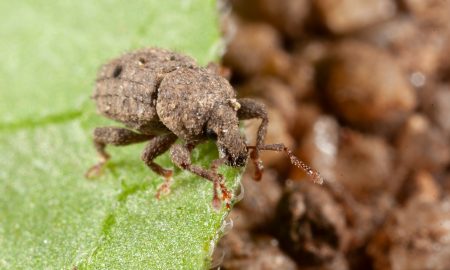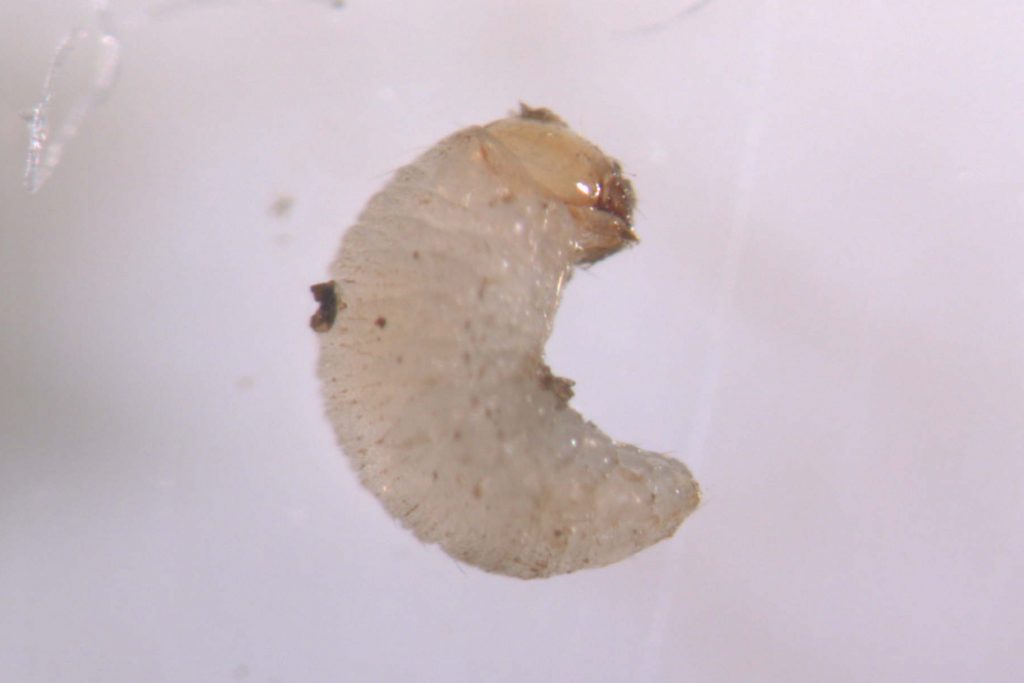Mandalotus weevil
Mandalotus spp.
Other common names
Rubble bug

Photo by Andrew Weeks, Cesar Australia
Summary Top
Mandalotus is a large genus of small, cryptic, native Australian weevils. At least ten species attack germinating canola crops in parts of south-eastern Australia. They occur mainly in areas with lighter soil types and are particularly common in Mallee regions. Weevil populations often recur within the same areas of paddocks across seasons. For these pests, understanding historical problem areas/paddocks, monitoring of emerging canola crops and early detection of weevil damage are critical to prevent crop losses.
Occurrence Top
Mandalotus weevils occur in parts of South Australia, Victoria and southern New South Wales, but are not recorded from Western Australia. They are found primarily on ‘rubbly’ or lighter calcareous soil types and are most commonly reported in Mallee regions. Mandalotus weevil populations are resident within paddocks and may recur in the same areas across seasons. The pest status of Mandalotus weevils in broad-acre crops has increased since the late 1990s, coincident with a dramatic expansion in canola production. The genus Mandalotus currently contains approximately 163 described species and a large number of undescribed species. At least ten species are known to damage to crops in south-eastern Australia.
At least ten Mandalotus weevil species are damaging to crops in southeastern Australia, and occur most commonly in areas with lighter soil types.

Description Top
Mandalotus adults are small, flightless weevils approximately 3-5 mm in length. They are round and dull brown in appearance, often resembling a small clod of dirt. Adults of some species may be mottled in colour but colouration varies somewhat within and between species. The elytra (wing covers on back of the body) are typically covered with rows of short, stout, paddle-shaped bristles. The snout is relatively short and broad compared with several other pest weevils. Eggs are approximately 1 mm in diameter, whitish and ovoid in shape. Larvae are small, legless grubs, pale in colour with a hardened yellow-orange head capsule. Eggs and larvae are rarely seen in the field.






Lifecycle Top
Mandalotus weevils have an annual lifecycle. Adults emerge onto the soil surface from mid-April onwards and begin feeding, mating and laying eggs. Females lay approximately 400 eggs during their lifetime and eggs hatch after 2-3 weeks.

Behaviour Top
Adults display cryptic behaviour, making detection and control difficult. They feed more actively at night, and during the day typically shelter in the top 1-2cm of soil at the base of plant stems. They are more surface-active in the several days following rainfall.
The largely subterranean life history and cryptic habits of Mandalotus weevils limit opportunities for cultural management.
Similar to Top
Adults of Mandalotus can be easily confused with those of several other pest weevils of a similar size class: spotted vegetable weevil (Steriphus diversipes), which is slightly larger and has a longer weevil snout; Polyphrades weevil (Polyphrades laetus), which is known to attack cereal crops on the Eyre Peninsula region of South Australia; Sitona weevil, which has a broad snout and three pale stripes on the thorax.
Crops attacked Top
Canola crops are highly susceptible to damage during the first few weeks after emergence. Other crops, including cereals, medic pastures, lentils, vetch, peas, chickpeas and beans, are also chewed but usually this does not cause significant damage.
Damage Top
Adults chew seedling stems, cotyledons and leaves. Canola seedlings are often ring-barked at ground level, resulting in lopping of seedlings, patches of crop thinning and, in severe cases, rapid destruction of large areas, which require re-sowing. In canola, damage is usually first noticed one week after emergence. Adult densities in excess of 300-400 per m2 have been recorded in germinating canola, causing widespread seedling losses. Young canola plants remain highly susceptible to severe damage until plant stems thicken, around the 4-leaf stage.


Monitor Top
Mandalotus weevil populations often recur in the same areas of paddocks across seasons. Knowledge of paddock history can identify areas at higher risk. From late April, check under isolated weeds (i.e. those surrounded by bare soil) for adults sheltering in the soil at the base of plant stems. Check canola crops one week after emergence for evidence of weevils and missing or lopped seedlings. Monitoring at night with a torch can reveal adults feeding up on the foliage of seedlings.
Mandalotus weevils recur in the same areas across seasons, therefore knowledge of paddock history can help identify areas at higher risk.
Economic thresholds Top
There are no economic thresholds established for this pest. Accurately assessing Mandalotus numbers in a paddock is difficult due to their cryptic habits.
Management options Top
Biological
There are currently no known biological control agents for Mandalotus weevils.
Cultural
Due to their largely subterranean life history and over-summering strategy, there are currently no cultural controls known to reliably reduce Mandalotus weevil populations within or between cropping seasons. But there is emerging evidence that that there may be some plausible options. For example, female egg production declines drastically in laboratory trials where females are continuously fed the foliage of crops other than canola, particularly cereals and some pulses (peas and chickpeas). Therefore, weed-free rotations with these crops could help reduce weevil populations in the following season. Increasing seeding rates and planting canola varieties with early vigour to aid rapid establishment may help reduce damage.
Chemical
There are currently no insecticides registered to control Mandalotus weevils in broad-acre crops. Some insecticides applied to control other establishment pests in canola crops may also provide some control of Mandalotus adults, while others may be largely ineffective. Refer to the SARDI ‘Mandalotus in canola’ Fact Sheet.
Acknowledgements Top
This article was compiled by Kym Perry (SARDI) and Bill Kimber (SARDI).
References/Further Reading Top
Henry K, Bellati J, Umina P and Wurst M. 2008. Crop Insects: the Ute Guide Southern Grain Belt Edition. Government of South Australia, PIRSA and GRDC.
Micic S, Hoffmann AA, Strickland G, Weeks AR, Bellati J, Henry K, Nash MA and Umina P. 2008. Pests of germinating grain crops in southern Australia: an overview of their biology and management options. Australian Journal of Experimental Agriculture 48, 1560-1573.
Perry KD, DeGraaf HD, Baker GJ. 2014. Biology, ecology and management of Mandalotus weevils (Curculionidae: Entiminae) in field crops in south-eastern Australia. Final Report for the Grains Research and Development Corporation (GRDC). South Australian Research & Development Institute, December 2014.
Perry KD 2013. Mandalotus weevils in canola. Entomology Fact Sheet. South Australian Research & Development Institute, May 2013.
| Date | Version | Author(s) | Reviewed by |
|---|---|---|---|
| May 2015 | 1.0 | Kym Perry (SARDI) and Bill Kimber (SARDI) | Garry McDonald (cesar) |
What are PestNotes?
PestNotes are information sheets developed through a collaboration between Cesar Australia and the South Australian Research and Development Institute (SARDI). Copyright: © All material published in PestNotes is copyright protected by Cesar Australia and SARDI and may not be reproduced in any form without written permission from both agencies.
Disclaimer
The material provided in PestNotes is based on the best available information at the time of publishing. No person should act on the basis of the contents of this publication without first obtaining independent, professional advice. PestNotes may identify products by proprietary or trade names to help readers identify particular products. We do not endorse or recommend the products of any manufacturer referred to. Other products may perform as well as or better than those specifically referred to. Cesar Australia and PIRSA will not be liable for any loss, damage, cost or expense incurred or arising by reason of any person using or relying on the information in this publication. Any research with unregistered pesticides or products referred to in PestNotes does not constitute a recommendation for that particular use.

